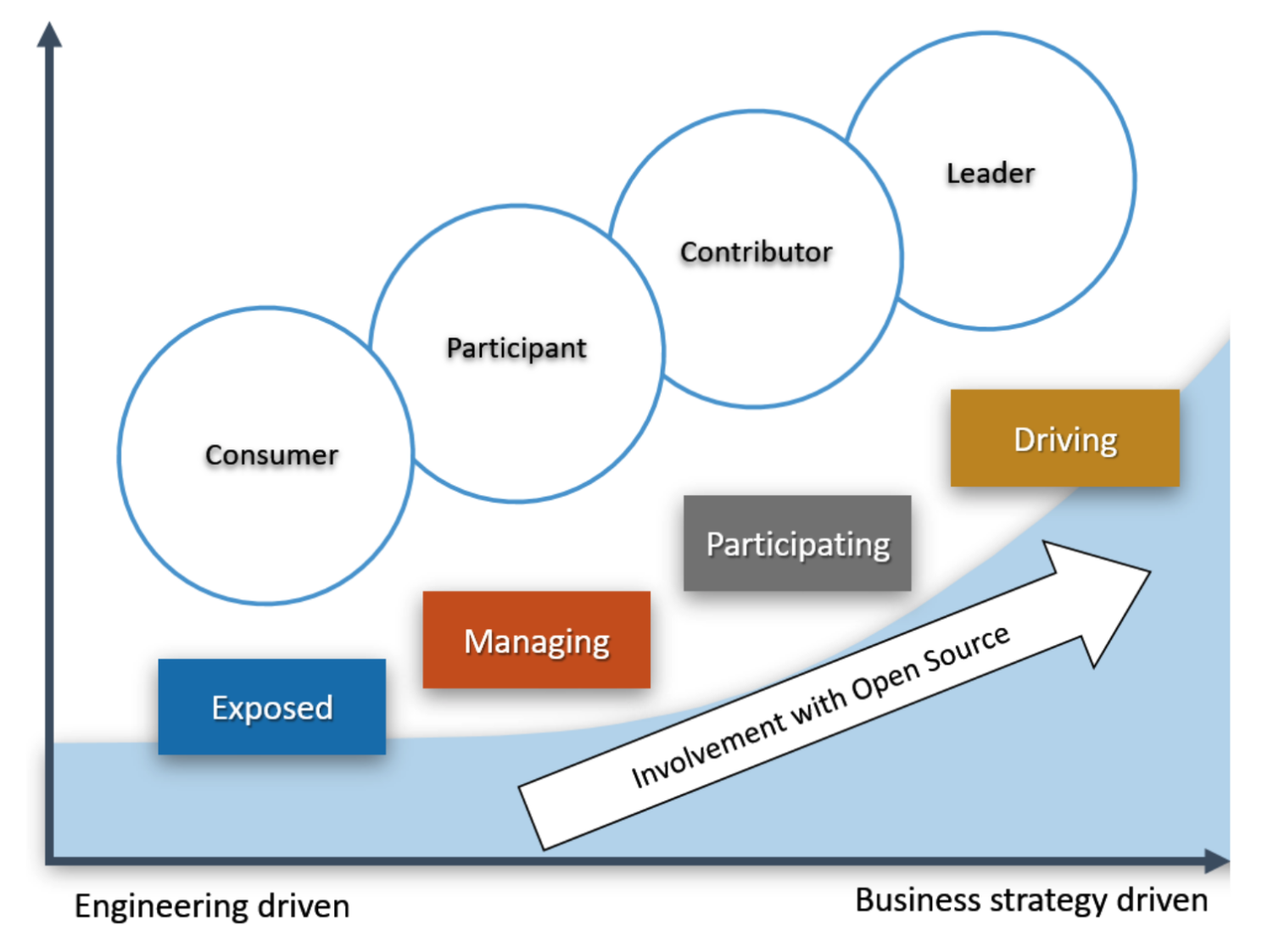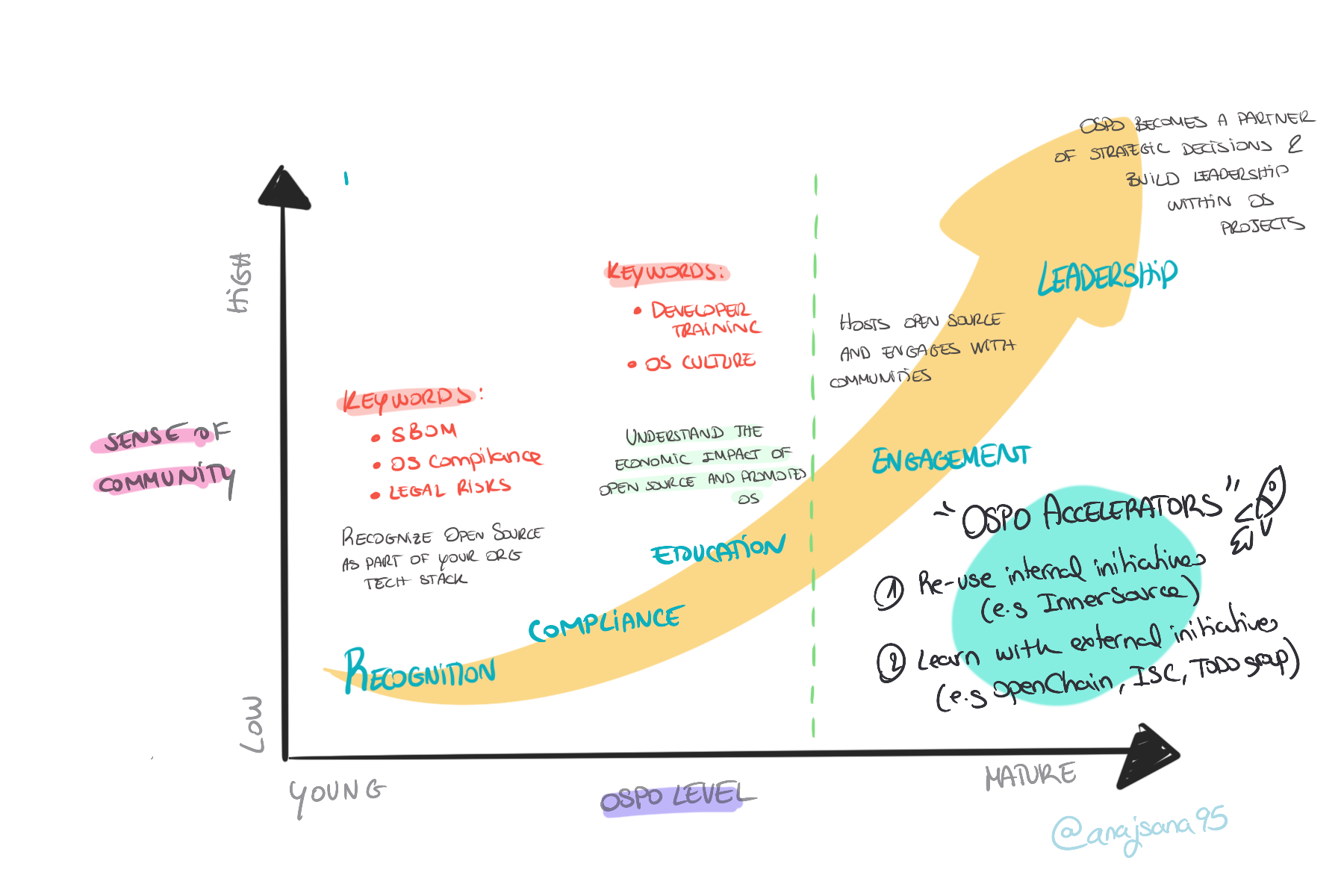Open source initiatives provide companies with proven, successful models to collaborate with other companies, create new technologies, and support the development of new technical communities. Companies across many industries are creating Open Source Program Offices (OSPOs) composed of highly skilled individuals to help them drive for a leadership position in open source projects and gain a critical footprint in this external R&D ecosystem.
How can OSPOs work as a pattern of innovation to gain sustainable competitive advantage? How can OSPOs collaborate with other communities to accelerate this process? In this article, you will learn about what OSPOs are, their strategic role within an organization’s open source journey, some of the OSPO layers and organization might face, and effective actions to accelerate these kinds of initiatives.
Table of Contents
- Introduction to OSPOs
- Pre-OSPO set up: Understanding the environment
- Moving your open source initiative to the next level: OSPO accelerators
- Building an OSPO infrastructure and network: OSPO Associates
Introduction to OSPOs
Disclaimer: There is a lot to say about OSPOs and this article is not intended to cover all. If you would like to learn more, you can check this introduction module of TODO’s OSPO 101 training course.
OSPOs are designed to be the center of competency for an organization’s open source operations and structure. This can include setting code use, distribution, selection, auditing, and other policies, as well as training developers, ensuring legal compliance, and promoting and building community engagement that benefits the organization strategically.
A strategic Ally to bring order into the organization’s open source operations
With more than 80% of modern application’s software components being open source, digital transformation is forcing more organizations to be open source forward and get involved with the open source ecosystem faster and securely.
However, due to the open source complexity, companies across industries are in a race to build up their open source operations under an Open Source Program Office (AKA OSPO) to accelerate this process in a more structured, secure, and efficient way. According to TODO OSPO’s 2021 survey, almost 80% of respondents who already have an OSPO, said their open source program had a positive impact on their software practices, while more 63% of respondents planning to create an OSPO said that they are expecting to initiate the process within a year.
OSPO Benefits
One of the many reasons is to consider OSPOs as the strategic Ally to bring order into the organization’s open source operations. If you have an aligned and dedicated person or team working on this on a strategic level, is more likely to coordinate and communicate your goals in a more efficient way across teams (legal, engineering, etc) that can be translated into saving time on bringing open source adoption to the organization. In the race towards digital innovation powered by open source adoption, time means everything.
Open Source adoption usually faces different stages, from a beginner interaction to a more complex one. According to one of the OSPO acticle from Ibrahim Haddad, the are four primary open source software strategies:
- Consumption
- Participation
- Contribution
- Leadership
Each strategy requires you to be successful at the previous strategy, and how far your company goes up this ladder is entirely up to your own discretion. This way, we can see these different stages as an open source journey.

As mentioned earlier, realizing that your organization is already using open source and finding ways to interact with this ecosystem, is no longer enough. At this point, more and more companies are launching an OSPO to accelerate this process and have a strategic business alignment across divisions and open source activities.
Disclaimer: the name OSPO came as a common name to standardize the Open Source Strategic Initiatives within an organization, which means, an organization might have different ways to call an OSPO depending on their size, department, and company values. This GH Discussion shows other OSPO names adopted by organizations across industries.
Pre-OSPO Set Up: Understanding the Environment
The same way we find different open source stages related to an organization’s open source involvement, OSPOs have their own journey as well. While there is a tendency to think that open source initiatives should also begin with external visibility in the open-source ecosystem, those community steps may not work until the organization asses a secure and supportive environment within their internal structure (it can be a hard task to try to build a community if there is no sense of community nor sense of security by the developers and high-level managers in the first place).
Disclaimer: There might be companies that already meet those criteria and might be able to start working on external activities such as organization’s developer engagement across open source projects.

Source: Building Bridges between ISPOs and OSPOs
We can see a different set of layers within an OSPO initiative, that may help us understand better the different stages this initiative might consider to move forward and grow .
OSPO Layers: Compliance, Policies, and Developer Education
Even though some of the OSPO activities are related to engaging with other open source projects, the most usual initial step is to work on a base layer about open source compliance, policies while paving the path to internal developer education, training, guides, documentation, and open source culture. Once these two layers are successfully accomplished, the OSPO can start to build engagement with the open source projects that matter to them, and start considering releasing their own projects as open source.

Source: Building Bridges between ISPOs and OSPOs
Moving your Open Source Initiative to the Next Level: OSPO Accelerators
There are initiatives or communities that can help your organization to accelerate your open source initiative or OSPO in different ways. To explain this idea, let’s split them into two main groups:
1) In-house Initiatives: Re-purposing Organization’s Assets
Some of these accelerators can be already implemented within the organization. Learning how to effectively communicate with other teams, re-allocate resources and re-use content are the main ingredients needed to avoid replication and work on things that have been already implemented by others.
Example: Building Bridges with InnerSource
There are some organizations that apply InnerSource to implement open source culture within an organization, due to the many benefits that this can imply. Usually, InneSource initiatives empower developer education and engagement using open source procedures in order to better collaborate and communicate across teams.
By looking at the lens of OSPOs, IS actions are at some point helping to build a supportive environment (e.g teams that know why is important to collaborate and how to collaborate to open source projects) within the organization and the OSPO team/professional can seize this opportunity. For instance, there might have documentation and process that OSPOs can reuse to accelerate developer education to contribute to open source projects.

2) External Initiatives: Neutral Players and Private Organizations
Nowadays, an OSPO team or professional is not alone. External communities and initiatives that advocate for open source and/or OSPO standards, foster open source networking and education, and keep building resources for other OSPOs, can be your best ally in the race for digital transformation.

Source: Building Bridges between ISPOs and OSPOs
However, the wide variety of initiatives out there, which such different scopes and expertise, can become a frustration to new OSPOs trying to figure out where these initiatives can help them.
For this reason, I’ve come up with some sort of division, that might clarify this part a bit:
| Type | Focus | Journey | Target | Characteristics |
|---|---|---|---|---|
| Enabler | Expertise in a specific Industry | Early Stage | For beginner organizations in engaging with open source | Open Source - Oriented initiatives to guide through open source best practices and adoption within specific sectors (e.g banking and finance). They also enable organizations to drive OSPO awareness and pave the path to start one |
| Guide | Expertise in OSPO adoption & Growth | Mid to Mature stage | For more mature organizations that see the benefits of having a more structured open source initiative or has already one | OSPO - oriented initiatives build for and by experts to guide others in establishing and nurturing an OSPO |
| Facilitator | Expertise in a specific subject | Early to Mature stage | For organizations looking for guidance on specific activities that demands their OSPO daily work (e.g community metrics, legal compliance, etc) | Initiatives or communities that can help specific activities across the different OSPO stages (e.g open source licensing and compliance on stage 1) |
When using this segmentation for external OSPO accelerators, we should also consider these two conditions:
OSPO accelerators are not exclusive: we might find hybrids
OSPO accelerators nurture each other: They define a path and can work collaboratively. For instance, Enabler and Facilitator type can act as OSPO satellites that send specific information for certain sections and resources and are filtered by the Guide OSPO accelerator before being processed by an OSPO.
Disclaimer: The following segments are intended to frame the kind of initiatives and communities that organizations can find based on common OSPO industry needs. This is not a fixed group of segments and is open to suggestions and feedback.
Building an OSPO Infrastructure and Network: OSPO Associates
The TODO group is an open group of organizations that want to collaborate on practices, tools, and other ways to run successful and effective open source projects. It’s a place where OSPO professionals can learn and build resources together focused on:
- Tooling: OSPO tooling initiated by the TODO Group community members.
- Network: Places to connect with experienced OSPO professionals and mentors
- Education: Resources & policy recommendations created by experienced professionals to keep learning about OSPOs
- Training: Course materials to train folks in OSPO management and implementation
- Research: Studies around open source and OSPOs.
The TODO Group recently launched the OSPO Associate Program with the aim to work collaboratively across communities that are helping the OSPO movement to build the most comprehensive OSPO solutions infrastructure and network. Communities like FINOS, OpenChain or LF Energy are getting involved. If you would like to find new ways to collaborate across communities, you can learn more at: https://github.com/todogroup/governance/blob/master/OSPO-Associate-Program.md
